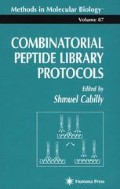Abstract
A number of systems have been developed over recent years that allow the selection of sequences with desired binding specificities from highly diverse, randomly generated peptlde libraries (1–3), When a member of a peptide library mteracts with a target blomolecule during one of these selections, both its primary sequence and its conformation play Important roles in the recognition process However, typically in these systems the peptides are tethered to one end of a fusion partner protein, where they possess many degrees of conformatlonal freedom. These flexible peptides may possess lower affinities for their target mole cules than the same peptldes presented as part of a folded native protein structure or in a more constrained cyclic structure (4–7). To circumvent this problem, various “protein scaffolds” have been proposed to help small peptides retain their conformations by restricting chain flexibility (8–10).
Access this chapter
Tax calculation will be finalised at checkout
Purchases are for personal use only
References
Smith G. P. (1985) Filamentous fusion phage. novel expression vectors that dtsplay cloned antigens on the virion surface Science, 228, 1315–1317
Scott J K. and Smith G P. (1990) Searching for peptide hgands with an epitope library Science 249, 386–390
Clackson T and Wells J. A. (1994) In vitro selection from protein and peptlde libraries. Trends Biotechnol 12, 173–184
Janm J. and Chothla C (1990) The structure of protem-protem recogmtion sites. J. Biol. Chem. 265, 16,027–16,030
O’Neil K T., Hoess R H., Jackson S A., Ramachandran N S., Mousa S A., and DeGrado W F (1992) Identification of novel peptlde antagomsts for GPIIb/ IIIa from a conformationally constrained phage peptlde library Proteins, 14, 509–515
Hruby V J. (1993) Conformation and topological considerations in the design of biologically active peptides Biopolymers, 33, 1073–1082
McLafferty M. A., Kent R. B., Ladner R C., and Markland W (1993) M13 bacteriophage dlsplaying disulflde-constrained mlcroproteins Gene, 128, 29–36
Nord K., Nilsson J., Nilsson B., Uhlén M., and Nygren P-Å. (1995) A combinatorial library of an α-helical bacterial receptor domain. Protein Eng 8 601–608.
Blanchi E., Folgorl A., Wallace A., Nicotra M., Acali S., Phahpon A., Barbato G., Bazzo R., Cortese R., Felici F., and Pessl A. (1995) A conformationally homogeneous combinatorial library J Mol Biol. 247, 154–160.
McConnellS J and Hoess R H (1995) Tendamistat as a scaffold for conformatlonally constrained phage peptlde hbraries J Mol Biol 250, 460–470
Katti S K., LeMaster D M., and Eklund H. (1990) Crystal structure of thloredoxm from E coli at 1.68 angstroms resolution J Mol Biol. 212, 167–184
Dyson H J., Glppert G P., Case D A., Holingren A., and Wright P E. (1990) Three-dimensiona solution structure of the reduced form of Escherichia coli thioredoxin determined by nuclear magnetic resonance spectroscopy Bzochemistry 29, 4129–4136.
LaVallle E R., Dlblaslo E. A., Kovaclc S., Grant K. L., Schendel P F., and McCoy J M (1993) A thloredoxm gene fusion expression system that clrcumvents mclusion body formation in the E coli cytoplasm Bio/Technology 11, 187–193.
Holingren A (1985) Thioredoxin Ann. Rev Biochem 54, 237–271
Colas P., Cohen B., Jessen T., Grishma I., McCoy J., and Brent R (1996) Genetic selection of peptlde aptamers that recogmze and inhibit cyclin-dependent kinase 2. Nature 380, 548–550
Scott J K and Craig L (1994) Random peptlde libraries Curr.Opin. Biotechnol 5, 40–48.
Wilson A R. and Beverldge T J (1993) Bacterial flagellar filaments and their component flagellms Can J Microbiol 39, 451–472
Lu Z., Murray K. S., Van Cleave V., LaVallle E R., Stahl M L., and McCoy J M. (1995) Expression of thloredoxm random peptlde hbrarles on the Escherichia coli cell surface as functional fusions to flagellm, a system designed for exploring protein-protein mteractlons. BiolTechnology 13, 366–372
Namba K., Yamashlta I., and Vonderviszt F. (1989) Structure of the core and central channel of bacterial flagella. Nature 342, 648–654.
Kuwajtma G (1988) Construction of a munmum-size functional flagellin of Escherichza colz J. Bacterial 170, 3305–3309.
Sambrook J., Fritsch E F., and Mamatis T. (1989) Molecular Clonzng A Laboratory Manual, 2nd ed Cold Spring Harbor Laboratory Press, Cold Spring Harbor, New York
McCoy J M and LaVallte E R. (1994) Expression and purtfication of thioredoxm fusion protems, in Current Protocols in Molecular Biology (Janssen K, ed.), Wiley, New York, Unit 16 8.
Diderichsen B (1980) flu, a metastable gene controlling surface properties of Escherihia colt J Bactenol. 141, 858–867
Ofek I andBeachy,E H. (1978) Mannose binding and epitheltal cell adherence of Escherichla coli Infect Immun 22, 247–254
Ponmah S., Endres R 0., Hasty D L., and Abraham S N (1991) Fragmentation of E coli type 1 fimbriae exposes cryptic o-mannose-binding sites J Bacteriol 173, 4195–4202
Harlow E and Lane D (1988) Antzbodles A Laboratory Manual Cold Spring Harbor Laboratory, Cold Spring Harbor, New York
Author information
Authors and Affiliations
Editor information
Editors and Affiliations
Rights and permissions
Copyright information
© 1998 Humana Press Inc., Totowa, NJ
About this protocol
Cite this protocol
Lu, Z., Tripp, B.C., McCoy, J.M. (1998). Displaying Libraries of Conformationally Constrained Peptides on the Surface of Escherichia coli as Flagellin Fusions. In: Cabilly, S. (eds) Combinatorial Peptide Library Protocols. Methods in Molecular Biology™, vol 87. Humana Press. https://doi.org/10.1385/0-89603-392-9:265
Download citation
DOI: https://doi.org/10.1385/0-89603-392-9:265
Publisher Name: Humana Press
Print ISBN: 978-0-89603-392-4
Online ISBN: 978-1-59259-571-6
eBook Packages: Springer Protocols

